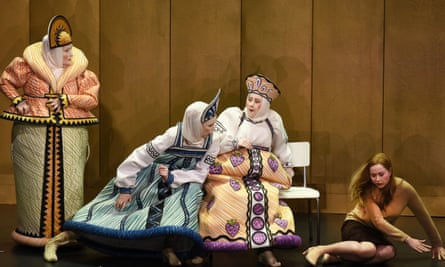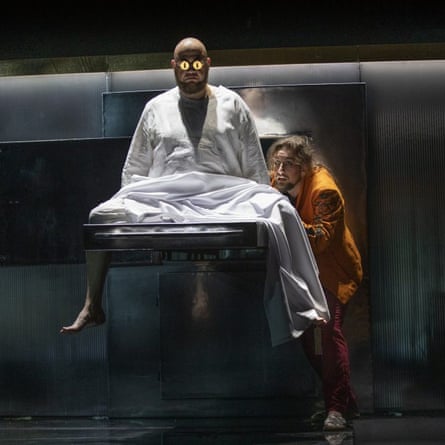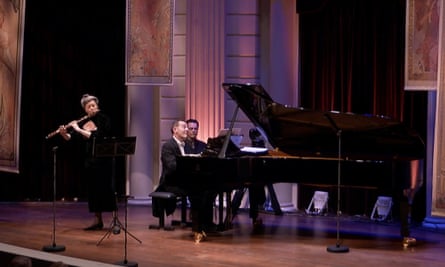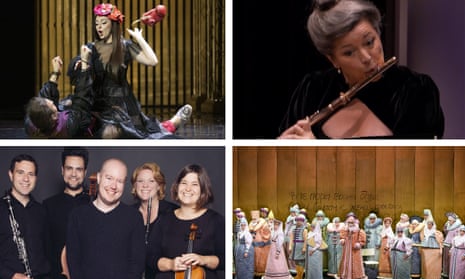Knussen/Ensemble Intercontemporain: Songs for Sue
Searching for Oliver Knussen’s fantasy opera Where the Wild Things Are – his magical evocation of the favourite Maurice Sendak story – led only to extracts. Yet even if all too brief, they can fire the aural imagination of a musical child, or indeed adult. A big plus instead was then finding Knussen’s precise and vividly conjured soundworld in the Ensemble Intercontemporain’s performance of Songs for Sue. Claire Booth was the soloist at its 2006 premiere: here again, her clear soprano and expressive way with words are moving. What Knussen called its “autumnal tone” stands – or so it seems now – not only as requiem for his wife Sue, but for him too. Visually, the care and insight of the direction serves to open up the score. The many excellent recordings by the same Ensemble Intercontemporain team are similarly attractive finds. That of Edgard Varèse’s Ecuatorial also combines aural and visual impact, this setting of a Spanish translation of the Mayan civilisation’s sacred Popol Vuh text a visceral and compelling tribute to a long-lost world. Rian Evans
The Tale of Tsar Saltan (La Monnaie, Brussels)

The Russian repertory always seems to bring out the best in director Dmitri Tcherniakov. He has made Rimsky-Korsakov’s operas a particular speciality, and this production of Tsar Saltan seems to me the finest of his Rimsky stagings so far – a brilliant reimagining of a work that can be easily undermined by the creaky dramaturgy of the libretto. Tcherniakov gives the fairytale plot a contemporary frame, which allows him to bring sense to the fantastical elements, played out in cartoon-like costumes referencing 1905 illustrations of Pushkin’s source poem, and also makes the end of the work genuinely moving. The action on stage is complemented by animated sequences, which are at their most virtuosic during the Flight of the Bumble Bee interlude; the way in which the two elements are seamlessly integrated is an impressive achievement in itself. And then there’s Rimsky’s lustrous music, which positively glows under conductor Alain Altinoglu, and a superb cast, in which Svetlana Aksenova as Militrisa, and Bogdan Volkov as her son Gvidon are exceptional. Surtitles are only in French or Flemish – try this synopsis for a quick plot overview. Also available on YouTube. Andrew Clements
Syzygy Ensemble: Dare to Hope
If now isn’t the time to explore concerts online that you couldn’t ever have attended physically, I don’t know when is. The Syzygy Ensemble are one of Australia’s top new music outfits and their recent performance at the decade-old Melbourne Recital Centre is beguiling, ear-bending stuff. There are works here rarely heard in the UK – New Zealander John Psathas’s Island Songs, for instance. It’s largely driven by nervous energy, but the jazz-inflected middle movement suddenly falls still, plucked cello notes echoed by bright piano chimes and dusky shadows from the clarinet. The highlight, though, is Australian Caerwen Martin’s The Beauty of Now, played with enormous sensitivity by Laila Engle (flutes) and pianist Leigh Harrold. It’s irresistibly spacious and resolutely slow to unfold. The filming is a no-nonsense single angle and the sound is so close-miked you can hear the musicians breathing and practically feel the grip of rosined bows on strings: a tad unforgiving of fleeting imperfections, but ideal for anyone missing the thrill of live performance. Flora Willson
Don Giovanni (Finnish National Opera)

Jussi Nikkilä’s Finnish National Opera staging of Mozart’s Don Giovanni earlier this year is essentially a portrait of an immoralist on the skids. It’s an unnerving, bleakly funny interpretation that charts the gradual descent of Tuomas Pursio’s charismatic, bisexual Don from self-assured sensuality into the drug-fuelled hallucinatory hell that is the outcome of his excess. Nikkilä takes occasional liberties with Mozart’s narrative and regrettably cuts the final sextet, and his ambiguous imagery can be both erotic and disturbing. Hanna Rantala’s Anna has become both the Don’s consensual partner and a witness to her father’s murder, while Markus Suikhonen’s exhibitionist Leporello has the list of his master’s conquests tattooed across his body. Patrick Fournillier’s conducting is all fiery exhilaration, and ensemble values are high, with the best performances coming from Suikhonen (outstanding), Tamuna Gochashvili’s tellingly manipulative Elvira and Tuomas Katajala’s elegant, principled Ottavio. It’s dark, edgy stuff and remarkably compelling. Tim Ashley
Royal Concertgebouw Orchestra: Emily Beynon Portrait

As well as a mouthwatering selection of performances under conductors such as Bernard Haitink, Ivan Fischer, Andris Nelsons and Mariss Jansons (though none, curiously, involving its music director of the 1990s, Riccardo Chailly), the website of Amsterdam’s great orchestra also features chamber performances from some of its members. The programme devised by principal flute Emily Beynon, with her cellist colleague from the orchestra Honorine Schaeffer and pianist Andrew West, is particularly interesting. Its mix of French and Czech music was inspired by the art nouveau painter Alphonse Mucha, who worked in both Prague and Paris: he befriended the young Janáček while his journalist son, Jiří, became a friend of Martinů. Beynon plays her own flute-and-piano arrangements of Debussy’s Prélude à l’Après-Midi and Janáček’s Violin Sonata, as well as a rather French-sounding piece by Geraldine Mucha, Jiří’s Scottish-born wife. Schaeffer and West also contribute Fauré’s second cello sonata, before the recital ends with Martinů’s Trio for flute, cello and piano; it’s a feast of top-quality instrumental playing. Andrew Clements

Comments (…)
Sign in or create your Guardian account to join the discussion